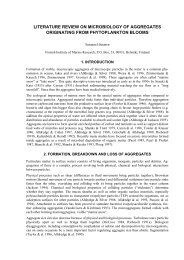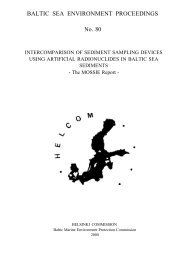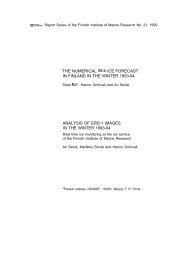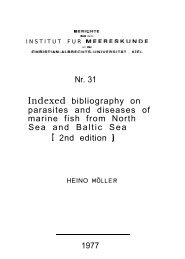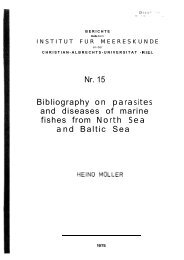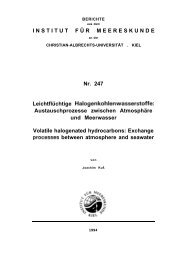marine research in finland - Baltic Marine Environment Bibliography
marine research in finland - Baltic Marine Environment Bibliography
marine research in finland - Baltic Marine Environment Bibliography
Create successful ePaper yourself
Turn your PDF publications into a flip-book with our unique Google optimized e-Paper software.
season (April-October}. The station has a maximum capacity of about 25 persons, (November-<br />
March about 10 persons), and on average 15-20 persons work at Husii {exclud<strong>in</strong>g field courses<br />
and sem<strong>in</strong>ars) from May to October. Husii is primarily used for education (field courses; also at<br />
Nordic level) and basic academic <strong>research</strong> at MSc, PhD, and postdoctorate levels. S<strong>in</strong>ce 1961<br />
Abe Akademi University and the Government of Aland have an agreement accord<strong>in</strong>g to which<br />
Huso Biological<br />
0<br />
Station is also used for monitor<strong>in</strong>g the aquatic environment (<strong>mar<strong>in</strong>e</strong> and limnic)<br />
on and around Aland (both general long-term monitor<strong>in</strong>g and specific case studies). Thus Husii<br />
Biological Station serves several purposes with<strong>in</strong> basic and applied aquatic (primarily <strong>mar<strong>in</strong>e</strong>)<br />
<strong>research</strong>, focus<strong>in</strong>g largely on issues related to the vast archipelago and coastal F<strong>in</strong>nish regions.<br />
The studies <strong>in</strong>clude rout<strong>in</strong>e field sampl<strong>in</strong>g, field experimentation (through SCUBA-div<strong>in</strong>g), and<br />
laboratory- and aquarium experiments. Sampl<strong>in</strong>g and analysis are done on hydrography and basic<br />
nutrients, pelagic primary production and planktonic organisms, phytobenthos, zoobenthos,<br />
fish and seabirds. Facilities <strong>in</strong>clude modem well-equipped laboratories, offices and teach<strong>in</strong>g facilities,<br />
aquarium facilities, hous<strong>in</strong>g, SCUBA- and general field equipment, and small boats for<br />
archipelago use. Scientific co-operation <strong>in</strong>cludes other F<strong>in</strong>nish <strong>mar<strong>in</strong>e</strong> stations and <strong>research</strong> <strong>in</strong>stitutes,<br />
and <strong>mar<strong>in</strong>e</strong> stations and universities <strong>in</strong> Scand<strong>in</strong>avia, NW Europe and the USA. About<br />
20 scientific papers, reports and academic theses are published annually.<br />
Ma<strong>in</strong> projects <strong>in</strong>clude (with<strong>in</strong> each project one or several separate studies):<br />
Long-term changes <strong>in</strong> the archipelago ecosystem (changes <strong>in</strong> nutrients, vegetation, zoobenthos<br />
and fish communities <strong>in</strong> time and space; eutrophication effects 1970’s to 1990’s), <strong>in</strong>clud<strong>in</strong>g<br />
comparisons Aland islands - Archipelago Sea - coastal Gulf of F<strong>in</strong>land and Gulf of<br />
Bothnia<br />
Mechanisms regulat<strong>in</strong>g structure and function for shallow water zoobenthos (meio- and<br />
macrofauna) and fish communities (general fish communities and small littoral fish); experiments<br />
<strong>in</strong> the field and laboratory (predator-prey <strong>in</strong>teractions, biodiversity as a function<br />
of community regulation and environmental parameters, food web structure and l<strong>in</strong>ks between<br />
trophic levels, the importance of physical and chemical stress such as drift algal mats,<br />
hypoxia, sediment redistribution, etc.)<br />
The ecology and ecophysiology of zoobenthos stressed by periodic hypoxia and anoxia<br />
The occurrence and ecological significance of drift algal mats on shallow (O-20 m) soft<br />
bottoms; seasonality, composition, nutrient release3 <strong>in</strong>teractions with phytobenthos (Fucus,<br />
Zostera), zoobenthos (recruitment, population- and community ma<strong>in</strong>tenance) and benthivorous<br />
fish<br />
Sediment quality and zoobenthos; results of SPI (sediment profile imag<strong>in</strong>g) <strong>in</strong> relation to<br />
traditional sediment analysis and zoobenthos studies (50 stations; 7-263 m depth)<br />
Successional models for <strong>Baltic</strong> Sea zoobenthic communities <strong>in</strong> time and space<br />
Mar<strong>in</strong>e plankton blooms and the microstratification of plankton; mechanisms beh<strong>in</strong>d sudden<br />
local plankton blooms, and the importance and distribution of s<strong>in</strong>gle species (biodiversity,<br />
ecology); cyanobacteria and d<strong>in</strong>oflagellates (red tides and possible toxic blooms), primary<br />
production, effects of eutrophication and traffic<br />
Macroalgae and macrophytes as <strong>in</strong>dicators of changes <strong>in</strong> the aquatic ecosystem (archipelago<br />
zone 1950’s to 1990’s; lakes 1930’s to 1990’s)<br />
The ecology of rocky shores and rock-pools; the importance of natural stress factors for the<br />
distribution, abundance and <strong>in</strong>terrelationships of epifauna (<strong>in</strong>clud<strong>in</strong>g long-term comparisons;<br />
1970’s to 1990’s)<br />
The biodiversity of snails <strong>in</strong> the lakes of Aland (“<strong>in</strong>verted island bio-geography”)<br />
Monitor<strong>in</strong>g studies for the Government of Aland (hydrography, nutrients, plankton, phytobenthos,<br />
zoobenthos and fish)<br />
23




